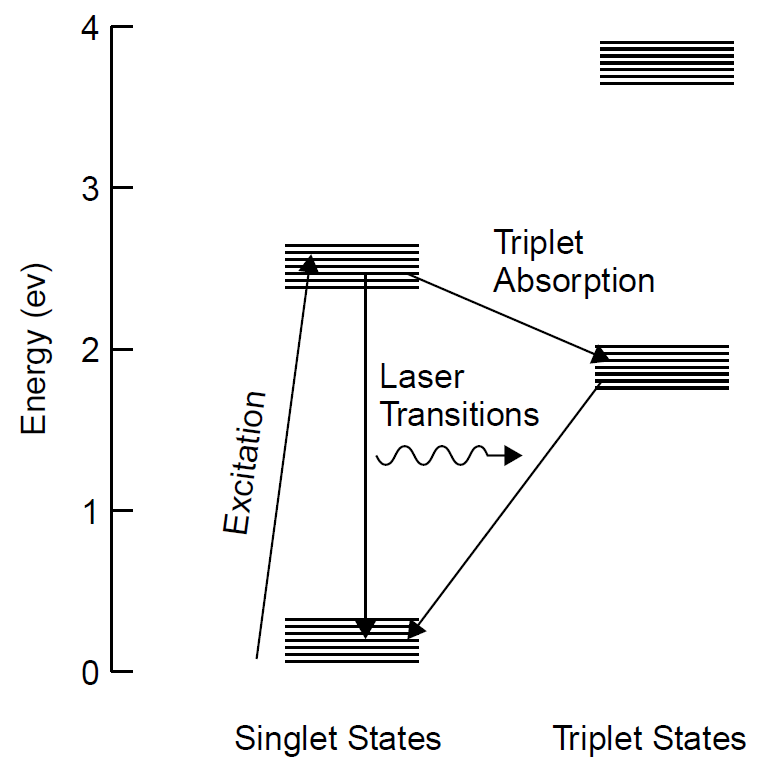


 الفيزياء الكلاسيكية
الفيزياء الكلاسيكية
 الكهربائية والمغناطيسية
الكهربائية والمغناطيسية
 علم البصريات
علم البصريات
 الفيزياء الحديثة
الفيزياء الحديثة
 النظرية النسبية
النظرية النسبية
 الفيزياء النووية
الفيزياء النووية
 فيزياء الحالة الصلبة
فيزياء الحالة الصلبة
 الليزر
الليزر
 علم الفلك
علم الفلك
 المجموعة الشمسية
المجموعة الشمسية
 الطاقة البديلة
الطاقة البديلة
 الفيزياء والعلوم الأخرى
الفيزياء والعلوم الأخرى
 مواضيع عامة في الفيزياء
مواضيع عامة في الفيزياء|
Read More
Date: 25-3-2016
Date: 24-3-2016
Date: 10-3-2016
|
LASING MEDIUM
In a dye laser the active medium is a fluorescent organic dye dissolved in a solvent (usually, an alcohol). The dye is pumped optically by a laser or by a flash lamp to produce a population inversion followed by stimulated emission to produce a laser gain. The dyes involved are large molecules with molecular weights in the range 400 to 500 amu. Most laser dyes belong to one of several families of dyes such as rhodamines or coumarins. Lasing begins when incident energy is absorbed by the dye, exciting it from the lowest singlet state to a high-energy level within the upper singlet band, as shown in Figure 1.1. From the high-energy level the dye falls to a slightly lower state within the same singlet band, which serves as an upper lasing level. A laser transition can then occur between the upper lasing level and the lower singlet state, which serves as a lower lasing level.
Dye lasers feature extremely broad energy bands allowing both absorption and emission over a wide range using wavelengths. Large absorption bands ensure efficient pumping of a dye, especially when a broadband source such as a flash lamp is used. In the case of laser output, tunability across a large range of wavelengths may be accomplished by employing a wavelength selector such as a diffraction grating in the cavity.

Figure 1.1. Laser dye energy levels.
An alternative pathway exists to foil laser action in the triplet states of the dye, also shown on Figure 1.1. That triplet states originate when excited electrons in the dye molecule spin in the same direction as that of the remaining electrons in the dye molecule (the singlet states result when the excited electron spins in the direction opposite to the lower-energy-state valence electrons still in the dye molecule). Because triplet states have lower energies than corresponding singlet states, dye molecules can easily migrate to those states and in doing so depopulate the upper lasing level. To make matters worse, triplet states are metastable and have much longer lifetimes than the singlet levels. When a short pump pulse such as that from a nitrogen laser (at 10 ns) is employed, triplet states do not form and do not present a problem for lasing, but when a flash lamp is used (which generally have pulse widths of over 1 μs), triplet states can form. For this reason, flash lamps must be designed to discharge as quickly as possible. Ordinary photographic strobes, for example, often have pulse lengths of 1 ms and will not work for pumping most dye lasers. In addition to a fast pump pulse to prevent triplet formation, triplet quenching additives can be mixed with many dyes, such as cyclooctatetraene (COT). These additives work by providing a deexcitation pathway from the triplet states, allowing the dye molecule involved to reenter the lasing process.
As evident from Figure 1.2, an enormous number of dyes are commercially available which span the entire spectrum from UV to IR. Dyes may be pumped by flash lamp or by a pump laser. Pump lasers include excimer, frequency-doubled or frequency-tripled YAG, nitrogen, or CW ion lasers. Regardless of the source, large power densities, typically around 100 kW/cm2, are required to pump a dye to a level where lasing is possible. It should also be noted that some success has been achieved by dissolving dyes into a host of resin which is solidified into solid acrylic. Such materials have been made to lase when pumped by another laser.

Figure 1.2. Laser dyes. (Courtesy of Exciton, Inc.)



|
|
|
|
للعاملين في الليل.. حيلة صحية تجنبكم خطر هذا النوع من العمل
|
|
|
|
|
|
|
"ناسا" تحتفي برائد الفضاء السوفياتي يوري غاغارين
|
|
|
|
|
|
|
ملاكات العتبة العباسية المقدسة تُنهي أعمال غسل حرم مرقد أبي الفضل العباس (عليه السلام) وفرشه
|
|
|